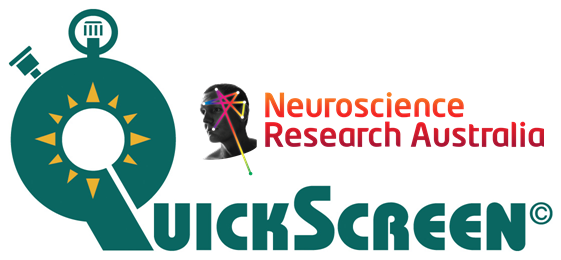QuickScreen

What is QuickScreen©?
Since there are many risk factors for falls which vary from person to person, individualised risk factor assessment should be the first step in developing effective intervention strategies for the prevention of falls in older people.
The NeuRA QuickScreen © Clinical Falls Risk Assessment (or QuickScreen © for short) was developed by researchers at Neuroscience Research Australia (NeuRA) and is a multifactorial assessment tool which was designed specifically for use in clinical settings. It has been rigorously tested in a large sample of community-dwelling older people in which it was found that performance in the QuickScreen © was able to accurately predict faller status. In a sub-group of these people, the QuickScreen © measures exhibited good reliability, demonstrating low measurement error and a high ability to detect change in physical status over time.
The QuickScreen © assessment has been trialled in several clinical settings with general practitioners, practice nurses and physiotherapists, where it was found to be quick and easy to administer, taking an average of 10 minutes to complete. The clinicians reported that the assessment provided useful information about risk factors and guided the implementation of intervention strategies. The QuickScreen © consists of the following measures: previous falls, medication usage, vision, peripheral sensation, lower limb strength, balance and co-ordination and requires the use of minimal equipment. This makes it a portable, easy to use assessment which has a low cost yet high accuracy in determining who is at risk of falling and which particular factors contribute to that risk.
The assessment also allows the user to calculate the combined risk increase that the identified risk factors present for future falls. The inclusion of this scoring system in the QuickScreen © allows for the identification of people who are at a high risk of falling, in addition to its ability to determine which specific factors contribute to that risk. This information can then be used to determine which intervention strategies are likely to be most beneficial in reducing the risk of future falls.
Download the QuickScreen© order form here
Access QuickScreen Test Resources:
- NeuRA QuickScreen Master Booklet (PDF)
- NeuRA QuickScreen Manual (PDF)
- Clinical Falls Risk Assessment Form (PDF)
FAQs for QuickScreen©
Both are multifactorial falls risk assessment tools, which are designed to identify people at risk of falls, to identify which specific risk factors are placing the person at risk and to guide interventions for the prevention of future falls.
The differences lie in:
a) the time taken to administer the assessments - Fallscreen takes 15-20mins, QuickScreen© takes 5-10 minutes
b) the need for specialised testing equipment - Fallscreen requires the use of several pieces of specialized equipment which is less portable than the QuickScreen©, which requires minimal equipment and fits into a small satchel
c) the interpretation of test results - Fallscreen requires the use of computer software to interpret the assessment results, QuickScreen© involves a simple scoring procedure which does not require computer processing
d) quantitative versus qualitative scoring - Fallscreen has a quantitative scoring method, allowing for the change in individual test scores to be compared over time, QuickScreen© uses a pass/fail tick box method of scoring, making it less accurate for comparison over time
e) cost - Fallscreen is a more comprehensive assessment with specialised equipment and costs $4,000 (excl. GST) for the short version and $8,000 (excl GST) for the long version, QuickScreen© costs $300.00 (excl. GST). Delivery cost upon request.
The protective sheet should be moved when doing the vision test. Tilt the chart to remove glare or change the light source.
The vision chart has not been used with NESB clients and is not validated with them. There are vision charts available for NESB clients which test the patients ability to identify the orientation of a shape (we have a Tumbling E chart as an alternative) but it has not been validated for predicting falls as yet.
Users need to consider whether they are applying the monofilament correctly. It must bend and be applied for approx one second to the lateral malleolus.
Each risk factor counts separately for the risk score calculation even if they are from the same risk area- this is because they have all been shown to be predictors of risk independently.
The components of the kit are available for purchase once a complete kit has been bought. The visual acuity chart and the touch rod (aesthesiometer) can be purchased for $75 each, plus postage. The stopwatch, foot placement squares and 3m string, all in a storage case can be purchased for $20 plus postage.
Yes, the template ensures correct positioning of the feet for the test and should be used.
Yes, the touch sensation test must be conducted on bare skin.
If you have any further questions regarding QuickScreen please contact the Falls and Balance team at fallscreen@neura.edu.au. To order a kit please download the order form above these FAQs.
